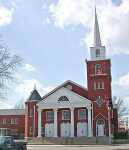Local church rich in history

By Steve Moyer
Nevada Daily Mail
In Nevada City, a new little town barely two years old, the Rev. Thomas German organized 20 residents to form a church congregation. Among the first members were Col. D.C. Hunter and W.W. Prewitt. Nevada City had no church building of any kind, so the congregation met in the Courthouse at first.
After 1860 the group, only calling themselves Christians in the manner of Barton W. Stone and Alexander Campbell, two early restorationists who believed that Christians should reject all creeds and stand on the word of God alone, met in the one-room frame schoolhouse but the congregation did not grow.
The Civil War intervened in civic life in Nevada City, situated near the border, the town was ravaged by the fighting that raged from 1861 to 1865. On May 26, 1863 the town was burned to the ground and only a few buildings, the school included, survived. The congregation's building was saved but not the congregation itself. The war had taken a toll on the families, many of whom left in search of a safer place to call home.
By 1868 Nevada dropped the "City" from its name and many of the families had returned and Elder H.J. Speed reorganized the Christian Church. On Sept. 12, 1868, Speed secured the support of 40 residents to start the church anew.
"This time it will last," Speed said.
At first the church lacked regular preachers, so elders of the church gave the sermons in various locations. After a decade the membership had grown enough not only to build a frame church on property purchased from Thomas H. Austin for $300, but to have a preacher.
The new church had a belfry and a bell, but no baptistry. New converts were baptized in the town lake, probably Radio Springs Lake. The treasurer of the church, Ralph Denny, made a habit of driving his team to pick up neighbors on the way to church.
By September of 1896 a new church had been built on the same spot, the old church having been moved a little to the west to the corner of Cedar and Austin so the congregation would have a place to worship as the new building was constructed. W.S. Creel placed a zinc box full of documents and copies of the local newspapers -- including the Daily Mail -- in the cornerstone of the $30,000 building.
One of the most striking features of the new red brick church building were the stained glass windows. The congregation was proud of the building and in the 1968 edition of the church annual, Dr. James A. Crain is quoted as saying, "The old church building was imposing and beautiful, easily the best church building in town. The art glass windows on the north and south sides of the sanctuary and on the west end were especially beautiful."
At the 50th anniversary of the dedication of the building several of the churches former ministers came back for the celebration. One, identified in the 1968 annual as Mr. Edwards, recalled his time at the Nevada church as one filled with memories.
"Many of my dearest memories are associated with this church," Edwards said. "It was my first pastorate after graduation from Harvard. It was here to Nevada I brought my bride, and it was here my son was born."
The red brick church lasted until Halloween, 1948, when a fire during a thunderstorm destroyed the structure. It was reported that flames shot 30 feet into the air in spite of heavy rain. Two boys, one whom Merl Church recently identified as Jim Woodfill, since deceased, broke a window with their fists and with bleeding hands and the help of others tried to save many of the church's records. Heavy smoke prevented them from completing the task.
During the year and one month when the church was being rebuilt using some of the congregation rented the church at the corner of Arch and Cedar, now the Calvary Baptist Church.
At the end of that period at a cost of $175,000 the church stood completely rebuilt and paid for.
A new cornerstone placed a little to the south of the old one, which is still in place, reads "Burned 1948 rebuilt 1949". It too has a sealed box, this one of copper, containing items of historical interest; a list of the church officers and members, a copy of the Golden Jubilee booklet and a history of the church written by Mrs. J. T. Hornback.
At the cornerstone ceremony May 21, 1949, the Grand Master of the Grand Lodge of Missouri Ancient Free and Accepted Masons , Harry F. Sunderland, assisted the church's board chairman N. P. Limbaugh, who officiated, in the ceremony. The building was dedicated and opened for services November 27, 1949.
A $71,000 addition to the building was started with children in Bible school classes turning the first shovelfuls of dirt in 1958.
On July 16, 1961, the annex was dedicated.
The decade of the 1990's was one of change for the church. Long a part of the Disciples of Christ denomination, the church decided to become an independent Christian Church after a meeting with denominational leaders.
"I'm the fourth pastor the church has had since it went independent," Bill Platt said. "Many members still feel strongly attached to the denomination."
In 2004 the church acquired the former Aldi grocery store building on the corner of Cedar and Austin, giving the church some much needed extra parking.
"We can really use it," Platt said. "We recently added parking to the east and we're already using all of that."
